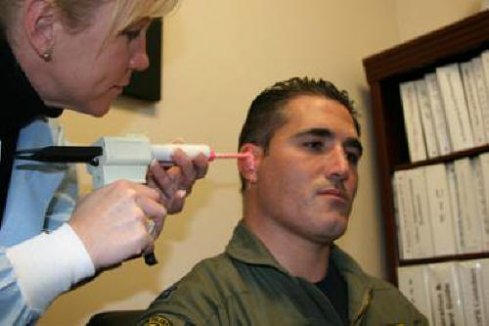
From Blackanthem Military News
HILL AIR FORCE BASE, Utah, January 11, 2006
A new earpiece is set to be implemented among Hill’s F-16 pilots affording them better hearing protection and an improved mission focus.
The 4th Fighter Squadron’s “Fighting Fuujins” will receive the new Attenuating Custom Communication Earpiece System this month. The earpiece was developed at Wright-Patterson Air Force Base by the Battle Space Acoustics Department. The Department is part of the Air Force Research Laboratory’s Human Effectiveness Directorate.
“The new system should increase communication intelligibility for our pilots,” said Capt. Eydin Hansen, Aerospace physiologist with the 75th Aerospace Medicine Squadron. “Currently the pilots are using foam earplugs and headsets with speakers that offer 8-12 decibels of protection, while sacrificing communication intelligibility.”
Currently, pilots are having a hard time hearing tones, many associated with air traffic controllers and ground-based controllers. The new earplug system costs less than $600 per person and is made from deep ear canal impressions from the pilots. It has a speaker system giving the pilots something similar to that used with an iPod, ultimately providing better clarity while giving them 25 to 30 decibels of protection.
This technology was initially designed for the ground crews and then adapted for the state-of-the-art F-22A Raptor. Hill pilots are excited to be using the next generation of hearing protection and communications device in the F-16 Fighting Falcon.
Capt. Dax Cornelius, 4th Fighter Squadron Demo Team member, said that while performing he experiences violent negative and positive G-forces and most of the time his earplugs tend to fall out.
“We’ll be flying with one plug in and one out,” he said. “It can be very distracting to have the radio blast in one ear and not in the other,” said Captain Cornelius. “This new system is really going to allow us to focus on the mission rather than the peripherals.”
By Shad West
75th Air Base Wing Public Affairs


Very cool, innovative solution. Sure to improve the cockpit environment for our pilots. The more focused they are the better able to do the job and stay alive. I know that in small single engine prop
aircraft how loud the cockpit can be. I earned a private pilots license in 1985. Can’t imagine the roar in a modern fighter aircraft. I’d love to hook a ride in one though to find out. 🙂
Hi RightToCarry, that is cool that you have a private plane license. Thank you for sharing.
I spent my AF career in Aircraft Maintenance working the heavies: B-52, KC-135, C-141, and B-2. I wish I would have gotten the opportunity to work fighters. It takes a lot of guts to strap a jet engine onto your butt and shoot through the sky at incredible speeds and their maintenance folks are among the best.
Since I am hard of hearing, I use the same sort of custom ear mold headset for my IPod player. There is a web site devoted to this type of headset and is aimed at rock and roll musicians who have lost their hearing and don’t want to lose more.
Hi Bob, thank you for sharing about your service. It really does take everyone to make things happen in our military and I have heard pilots comment on how glad they are for their Aircraft Maintenance guys.
You worked on some awesome planes.
Hi Jake that is interesting. Thank you for commenting and sharing.
Thanks WT, I’m no longer certified to fly due to health problems, but it was a great experiance.
Bob, with out great ground crews the planes don’t fly. Thanks for helping to keep the fly boys up in the air.
RightToCarry I am so sorry. I bet it was an awesome feeling.